
- Dave Trott
Folded Refractor
This telescope is a four-inch f/15 refractor. It offers many of the advantages of the really expensive fast APO refractors in this aperture but cost a small fraction of such exotic telescopes. It is fairly short and compact; not much larger than an APO. In addition it has a long focal length, so it gives you high magnifications with long focal length eyepieces so you don't need to use a 4 mm eyepiece to see detail on Jupiter. It has almost NO color. In this aperture the chromatic aberation of an achromat at f/15 is nearly nil. There is none visible at the eyepiece. So the performance is as good as an APO.
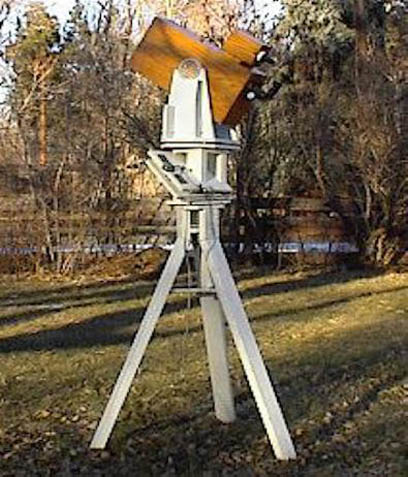
The mirrors are important components in this telescope. They must be good, flat mirrors. Luckily such mirrors are commonly available to amateur telescope makers. In these sizes you can buy elliptical flats designed for newtonians for very reasonable prices. Since they are fairly small, they reach ambient air temperatures rapidly. My telescope requires cooling for a few minutes when it experiences a 40 or 50 degree change in temperature.
Knife-edge baffles are a bit of overkill in my opinion but baffles are a good thing. The main idea is to keep stray light out of the eyepiece. When your eye is where the eyepiece should be the only thing you want to see is the primary lens. But be careful not to block light to the EDGE of the eyepiece, or you could defeat the purpose by decreasing your effective aperture.
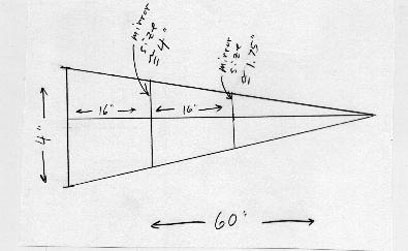
This diagram shows the symbolic layout of a folded refractor like mine. It's a simple diagram which allows you to figure out the required mirror or baffle dimensions. The sizes you measure on this diagram should be increased by about 10 percent to allow for placement errors and possible vignetting. Note: the scale on the horizontal axis need not be the same as the scale on the vertical axis. If this bothers you make both the same on your version. The dimensions depend on the backfocus you need for your focusser. The size of the box depends on the dimensions of your mirror holders. Build this from the inside out and put the box around all the components when you have them built. Do a complete diagram of the telescope with the folds included before you begin construction.
The only thing I would do differently on this scope would be to slightly increase the size of the folding mirrors. They have to be big enough to adjust a bit during collimation and that adjustment could shift them a tiny amount causing a trace of vignetting...not a serious problem, but to be avoided if possible.
Collimation is not as complicated as you might think. It's really not much worse than with any refractor. The only potential problem is vignetting. If you oversize the mirrors a bit, you won't have any problem. All you need to do is hold a point light source (like a penlight) near your eye and look down the focuser tube from the eyepiece end. Simply adjust the mirrors and primary until all the reflections from all the glass surfaces are coincident and you can see the entire objective.
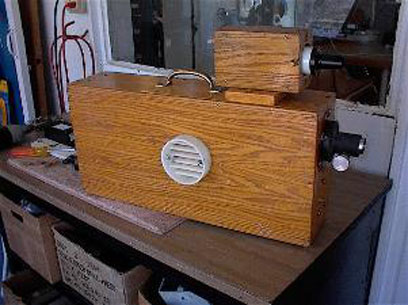
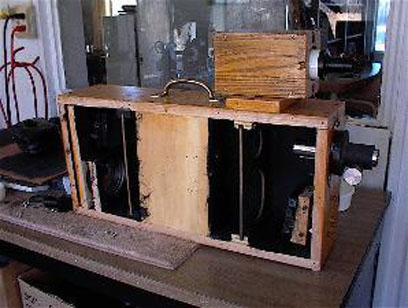
In the pictures you can see that I've put some baffles in my telescope. These are fairly important in any refractor and they may be more important in this telescope.
Here's a schematic diagram. Compare this to the above photos.
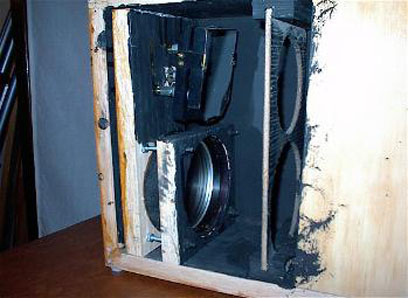
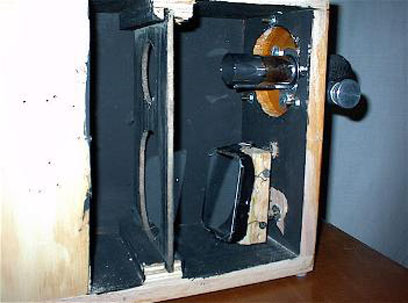
The mirrors are mounted in simple adjustable cells much like the primary of a reflector except that they are tilted slightly.
Finder
The finder for my telescope is an ordinary 8x50 mounted inside an Oak box to be harmonious with the appearance of the main telescope. It can be adjusted by turning the four thumb screws at the rear of the box.
This is a really fun ATM project. And the result is a telescope that costs about half as much as an APO and performs as well or better.
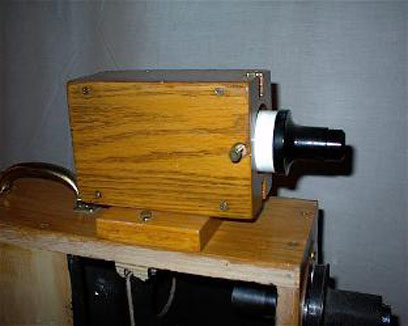
Design Considerations
I don't have any plans for these scopes but they are easy to design. For the tilt angle just draw a perpendicular from the center of your folding flat. If you need to reflect the incoming ray from the primary by 10 degrees then the perpendicular will be tilted by 5 degrees from the incoming ray of light. The flats have to be big enough to send all the light cone from the objective down the path. They should be a little oversized to allow for adjustment and make sure you have a fully illuminated field. Circular mirrors are best for small folding angles but an oversized elliptical will work just fine.
A few scale drawings with your particular objective will tell you what you need. The most important thing is to get good quality flats....this could be expensive in your case depending on how many folds you use, etc. If you can't find anything suitable at a reasonable price get back to me. I have a small stock of quality flats that I may not need for my own projects.
As for mounting the flats...read Richard Berry's book Build Your Own Telescope on mounting the primary of a Newtonian. The problem is identical. You want to mount the mirror so that it is not pinched and it can be adjusted to provide for the final collimation of the optical train. A more-or-less traditional Newtonian primary cell will work fine in most cases. If the tilt angle is small you might even be able to mount the entire thing "square" and allow the cell adjustment to provide all the tilt you need.
I have compared my folded 4" with a traditional Tinsley (Very High Quality!) scope of the same aperture and focal ratio. They are identical under careful testing after the folding mirrors cool to ambient temperature.
However a friend of mine who is a professional optical designer has cautioned me that the flats must be good...each flat introduces a bit of it's own error into the wave train from the objective. He ran some numbers and the conclusion was that you cannot tolerate large errors in the flats or you will ruin the image. Luckily, good quality flats are not uncommon and not too expensive in smaller sizes. My advice is to carefully check the image with a star test with your scope in a traditional configuration. Then when you have your folded scope assembled and fully adjusted compare it to make sure you have not lost any image quality. Be sure to allow the mirrors to cool. A simple star test will tell the tale. Read Berry on this topic.
You can pay very high prices for guaranteed flats or take a chance that an off-the-shelf Newtonian secondary will be good. The smaller the flat the less chance you are taking because it's easier to make a good small flat. You can "sort-of" test the flats if they are big enough by looking at an image of Jupiter or the moon through a good telescope that is aimed down at the flat such that the image is being reflected in the flat. Do a star test this way, if you want. If the reflected image is as good as the unreflected image then you are sure that the tested flat is at least as good as the testing telesope. As long as your testing telescope is of good optical quality and has about the same aperture as the flat (or is larger) you are effectively testing the entire surface of the flat. I know from experience that a poor flat will show up immediately and obviously! Be sure to look straight at the same target on the same night to make sure that what you are seeing is really in the mirror and not in the atmosphere (the "seeing").
If you decide to build a folder refractor please let me know how your scope works out and if my advice here was helpful to you.
Good Luck!
